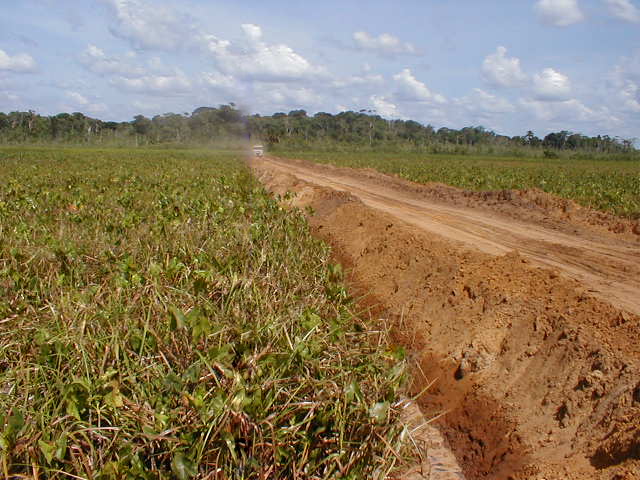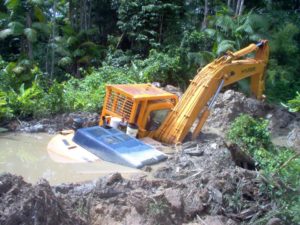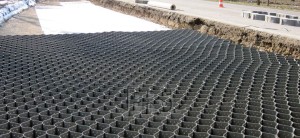Several years ago I did some geotechnical consulting for BHP’s bauxite mining projects along the north coast of Suriname. The mines were located in swampy terrain, underlain by very soft clays. The picture below shows the typical landscape when crossing one of the swamps. Haul roads were needed to access the small satellite bauxite pits, which were spread apart several kilometres. The high ground in the background is one such bauxite deposit.

Suriname swamp road for mine
Unfortunately where haul road construction was concerned, there were no nearby gravel pits or road aggregate supplies. However there were significant amounts of fine sand on the high ground “islands” in the swamp. Road building mainly relied on end dumping truck loads of sand, allowing it to settle and sink into the swamp. Then continue adding more and more sand until the settling process stopped. This resulted in high cost roads and very slow progress in construction. Periodic rainfalls, daily during wet season, would cause havoc with the trafficability on the fine sands.
Swamp vegetation to the rescue

How soft were the swamps clays? See the photo to the right.
Where there was significant swamp vegetation (like in the photo above), it would be buried by the fill, helping to form a mat. This supported the road fill and minimized the sand losses into the sub-grade. However in some parts of the swamp the vegetation was minimal and therefore sand settlement losses could be high.
Geotextiles were applied in some areas, using a geogrid. These were successful although large amounts of sand were still required as the entire road would compress the underlying clay.
Once a road was built, the next issue was the trafficability on the fine sand surface, especially after rains. The sand would rut and require constant grading and repair.
Final road capping would consist of hard laterite when available. Laterite is a high iron off-grade bauxite that could be compacted to form a hard surface but would still degrade and get slippery when wet.
If coarse aggregate had been available locally, road performance would have been much better. However we had to work with what was available.
Geo-cells would have helped

A few years later I saw a video about a geo-cell solution for building roads with sand only. The website is The PRS-Neoweb™ Cellular Confinement System (www.prs-med.com). I think there are other similar geotextiles available but this is one that is well described on their website. Sand is placed into the geoweb, which eventually forms a stiffer layer. I assume that one could place the sand using mobile equipment or by hydraulically pumping coarse sand as a slurry.
In hindsight, I would have liked the opportunity to test the geo-cell system in the swamps of Suriname. Potentially it would have been a good solution to prevent both sand losses and to create a more trafficable surface.
I’m not certain if the best location for the geo-cell would have been along the sub-base of the road to support the sand load or near the surface to help create a more trafficable surface. Maybe it would have been beneficial in both situations.
Building a road over a swamp in Suriname is somewhat similar to building a road out onto a tailings pond. Possibly the geo-cells would have application there too.
Use Hydraulic Sand
Another large earthwork project we undertook in Suriname was building a dragline walkway across a swamp. The walkway was 4 km long, 30 m wide and about 2 m thick. That required a lot of fill. This walkway was built using hydraulic sand. Boskalis, a Dutch dredging company, collect sand from the bottom of the Suriname River, barged it to a staging site about 5 km from the walkway, and then pumped the sand to the construction site.
The hydraulic sand was discharged between two bunds where it quickly settled out. It was somewhat similar to a tailings disposal operation. Placing the sand using this approach was low cost and didn’t require trucks driving out onto the swamp. It also advanced the road with a very shallow front face, avoiding slumping failures or mudwaves ahead of the advance. A few softer sections of the walkway route also incorporated geotextiles.
Engineering teams need to look at options since different procedures may be required when building roads over swamps due to the unstable conditions one may encounter.
Conclusion
Geotextiles have many applications in the mining industry. There can be significant up-front costs to purchase and install them but don’t let that scare you away. The savings may been seen down the line. They are definitely worth a look.
The big issue in Suriname were clays, both under the roads and in the overburden above the bauxite deposits. Clays can have many forms, all of which can be problematic to deal with. I have written another blog post about my experiences with the different types of clay and how they may behave. If interested, check it out at “Clays and Mining – Friends or Foes?“
Note: You can sign up for the KJK mailing list to get notified when new blogs are posted. Follow me on Twitter at @KJKLtd for updates and other mining posts.





 The term Theory of Constraints may be common to some. However that concept is different than what is being discussed in the book. The TOC essentially relies on managing a constraint or eliminating it, and then addressing the next constraint in sequence.
The term Theory of Constraints may be common to some. However that concept is different than what is being discussed in the book. The TOC essentially relies on managing a constraint or eliminating it, and then addressing the next constraint in sequence.




 The tech start-up model is similar to the junior mining business model as it relates to early stage funding followed by additional financing rounds. One obvious difference is that mining mainly uses the public financing route (IPO’s) while the tech industry relies on private equity venture capital (VC’s).
The tech start-up model is similar to the junior mining business model as it relates to early stage funding followed by additional financing rounds. One obvious difference is that mining mainly uses the public financing route (IPO’s) while the tech industry relies on private equity venture capital (VC’s). My first experience with the tech industry was associated with the many after-hours networking meetings called “meetups”. They are held weeknights from 6 to 9 pm and consist of guest speakers, expert panels, and for general networking purposes. Often guest speakers will describe their learnings in starting new companies and failures they had along the way.
My first experience with the tech industry was associated with the many after-hours networking meetings called “meetups”. They are held weeknights from 6 to 9 pm and consist of guest speakers, expert panels, and for general networking purposes. Often guest speakers will describe their learnings in starting new companies and failures they had along the way. Most of the tech meetups are held in local tech offices. These offices are great. They have an open concept, pool tables, ping pong, video games, fully stocked kitchen. Who wouldn’t want to work there?
Most of the tech meetups are held in local tech offices. These offices are great. They have an open concept, pool tables, ping pong, video games, fully stocked kitchen. Who wouldn’t want to work there? In the late 1990’s I was working in the Diavik engineering office in Calgary. They provided a unique office layout whereby everyone had an “office” but no front wall on the office so you couldn’t shut yourself in. There were numerous map layout tables scattered throughout the office to purposely foster discussion among the team.
In the late 1990’s I was working in the Diavik engineering office in Calgary. They provided a unique office layout whereby everyone had an “office” but no front wall on the office so you couldn’t shut yourself in. There were numerous map layout tables scattered throughout the office to purposely foster discussion among the team.
 One specific example that I have seen is related to the 2015 disposition of foreign resource assets by both Barrick and Ivanhoe to Zijin, a Chinese company. I don’t know much about Zijin, other than having heard Norway’s government directed its $790 billion oil fund to sell holdings in some companies because of their environmental performance. Zijin was one of these companies.
One specific example that I have seen is related to the 2015 disposition of foreign resource assets by both Barrick and Ivanhoe to Zijin, a Chinese company. I don’t know much about Zijin, other than having heard Norway’s government directed its $790 billion oil fund to sell holdings in some companies because of their environmental performance. Zijin was one of these companies. It will be interesting to see whether the idea of governments sanctioning the acceptability of acquirers in the mining industry will gain traction.
It will be interesting to see whether the idea of governments sanctioning the acceptability of acquirers in the mining industry will gain traction.
 Irrespective of 43-101, if you are working at a mining operation the last thing you want to do is present management with an incorrect reserve, pit design, or production plan.
Irrespective of 43-101, if you are working at a mining operation the last thing you want to do is present management with an incorrect reserve, pit design, or production plan. As a QP, I suggest the onus is on the software developers to demonstrate that they can produce reliable and comparable results under all conditions. They need to be able to convince the future users that their software is accurate.
As a QP, I suggest the onus is on the software developers to demonstrate that they can produce reliable and comparable results under all conditions. They need to be able to convince the future users that their software is accurate.
 A failure cleanup fund
A failure cleanup fund

 So there likely is a significant network of experienced people out there. It’s just a matter of being able to tap into that network when someone needs specific expertise.
So there likely is a significant network of experienced people out there. It’s just a matter of being able to tap into that network when someone needs specific expertise.

 Changes in economic parameters would impact the original pit optimization used to define the pit upon which everything is based.
Changes in economic parameters would impact the original pit optimization used to define the pit upon which everything is based.
 Mining companies are constantly in the media with stories of cost over-runs, mine shutdowns, fatalities, strikes & protests, and environmental incidents.
Mining companies are constantly in the media with stories of cost over-runs, mine shutdowns, fatalities, strikes & protests, and environmental incidents. The larger mining companies will always have their investors like pension funds and mutual funds, however the junior miners may be a different story.
The larger mining companies will always have their investors like pension funds and mutual funds, however the junior miners may be a different story.